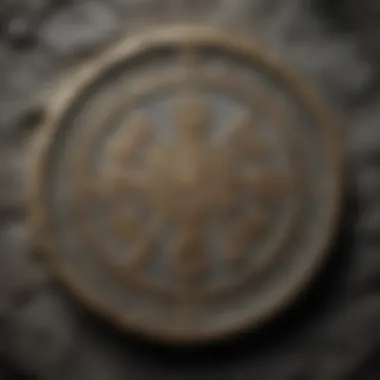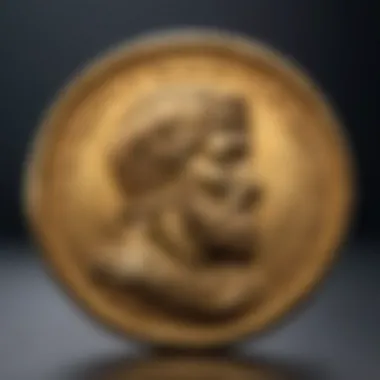The Historical Importance of Constantinople Coins


Intro
The study of ancient coins provides vital insights into the historical context of civilizations. In the case of Constantinople, coins not only functioned as currency but also carried profound cultural and economic implications. This article delves into the multifaceted significance of these coins, offering an exploration of their historical origins, designs, and impact on trade within the Byzantine Empire and beyond.
History and Origins
The Evolution of Coinage in Constantinople
The practice of minting coins in Constantinople began during its establishment. Its strategic location made it a crucial hub for trade, connecting Europe and Asia. The coins produced here evolved over centuries, reflecting the city's changing social and economic landscapes.
Initially, coins bore simple designs, often displaying the likeness of the reigning emperor. As the city flourished, so did the intricacy of coin designs. Byzantine coins began to incorporate various symbols, such as depictions of saints and religious iconography, which signified the cultural identities of the time.
Historical Significance and Cultural Impact
Constantinople coins serve as historical artifacts, encapsulating the essence of Byzantine society. They reveal the empire's wealth and power, influencing trade routes and interactions with different cultures. The designs on these coins often indicated allegiance to the state and religion, effectively intertwining economic and cultural narratives.
"Coins are snapshots in time, offering a glimpse into the values and priorities of past civilizations."
The impact of these coins stretched far beyond the marketplace. They became a medium for propaganda, showcasing the legitimacy of rulers and their divine right to govern. Furthermore, they played a role in unifying a diverse empire, while also illustrating the intricate social hierarchies present.
The Numismatic Landscape: Understanding Significance
Notable Coin Types
Among the various types of coins minted in Constantinople, some notable examples include the solidus and the histamenon. The solidus was a gold coin that became the standard for Byzantine currency, celebrated for its consistent weight and purity. The histamenon, on the other hand, was a silver coin that also gained popularity for trade within the empire.
The Role of Collectors
In contemporary times, the significance of these coins has not diminished. Collectors and historians examine them to glean insights into economic history and the art of coin-making. The demand for such artifacts highlights their enduring value and the continued interest in the Byzantine era.
Culmination
The examination of Constantinople coins offers a profound understanding of the city's role in history. Beyond serving as mere currency, they acted as conduits for cultural exchange, social structure, and economic networks. As we untangle these historical threads, we begin to appreciate how the coins of Constantinople reflect broader narratives and contribute to our understanding of the past.
Prolusion to Constantinople Coins
Coins from Constantinople hold profound significance in the historical narrative of finance, culture, and politics. Their role transcends mere currency, revealing layers of societal values, power dynamics, and economic systems. Through the lens of numismatics, these coins emerge as crucial artifacts that guide us in understanding their era's geopolitical climate and economic interactions.
Defining Coins in the Context of Constantinople
In the context of Constantinople, coins served not only as a medium of trade but also as a representation of authority. The act of minting coins was intrinsically tied to the sovereignty of the empire. Coins carried the images of emperors, often inscribed with titles that conveyed legitimacy and power. Each coin type, such as the gold solidus or silver siliqua, carried distinctive designs that reflected the empire's values and aspirations.
These coins were symbols of trust, as their weight and material content assured merchants of their value. Beyond commerce, they communicated messages regarding the political and cultural identity of the Byzantine Empire. Thus, the study of these coins unveils insights into the historical progress of the region, highlighting shifts in power and economic strategies.
The Geopolitical Importance of Constantinople
Constantinople was strategically significant, sitting at the crossroads of Europe and Asia. This placement fostered vibrant trade networks, making the city a bustling hub of commerce. The coins minted in Constantinople illustrated this economic might. They facilitated trade not only within the empire but also with distant lands, thereby integrating various cultures and economies.
The production of unique coinage linked to the city also reinforced its status as a major power. Trading partners recognized the currency, facilitating smoother transactions. Therefore, understanding the geopolitical importance of Constantinople coins provides essential context to their economic discussions. Coins became the threads binding diverse communities together in a vast tapestry of trade and exchange.
"Coins are the reflection of a society's values, negotiating trust and facilitating trade across regions."


Historical Background of Coinage in Constantinople
The historical background of coinage in Constantinople is vital for understanding its significance in trade and culture. Coinage acted as a powerful reflector of the social, political, and economic conditions of the time. The establishment of Constantinople as a capital was a turning point, not only in governance but also in the development of an extensive monetary system that would influence regions far beyond its borders.
Coins were more than mere currency; they were instruments of policy, tools of propaganda, and conduits of commerce. Understanding their origins and evolution gives depth to how they shaped interactions among nations and peoples, allowing one to appreciate their multilayered impact.
The Beginnings of Coin Production
The beginnings of coin production in Constantinople can be traced back to its establishment in 330 AD by Emperor Constantine the Great. The initial coins produced were heavily influenced by earlier methods used in the Roman Empire. These coins were often struck from precious metals like gold and silver, focusing on a balance of weight and purity to maintain value in trade.
The introduction of the solidus symbolized the city's ascendancy and stability. The solidus was a gold coin that weighed about four grams and was introduced as a standard against which other coins were measured. This coin supported the economic framework of the Byzantine Empire, facilitating commerce both locally and across the Mediterranean.
Influence of Roman Coinage
Roman coinage left a profound mark on the coinage of Constantinople. As the Byzantine Empire emerged from the remnants of the Roman Empire, the influence was evident. Roman coins were designed not just for utility but also as art. They portrayed emperors, gods, and various symbols that reflected the values and political landscape of the time.
The coinage system emphasized stability through standards that evidenced a robust state apparatus. Coins often carried designs that underscored the might and divinity of emperors. The shift from the solidus to other denominations like the siliqua and follis showcased adaptability in response to economic needs while retaining homage to established traditions.
"The legacy of Roman coinage echoes throughout the Byzantine period, merging governmental authority with cultural continuity."
This backdrop set the stage for the extensive and diverse coinage system that would follow in Byzantium, honoring its predecessors while charting an independent course. Each coin was a historical artifact that conveyed the legacy, values, and aspirations of a civilization shaped by centuries of tradition and change.
Types of Constantinople Coins
The exploration of Constantinople coins reveals their critical roles in history, economy, and culture. The coins minted in this ancient city not only represent a standard of currency, but they also signify a reflection of the broader socio-political context of their times. By categorizing the various types of coins minted in Constantinople—gold, silver, and bronze—we can paint a more comprehensive picture of their importance and the influences that shaped them. Each type serves its unique purpose, carrying distinct features that influenced trade, politics, and artistry.
Gold Coins: Solidus
Gold coins, particularly the Solidus, were among the most prestigious in the Byzantine Empire. Established by Emperor Constantine I, the Solidus typically weighed around 4.5 grams and held a high value that facilitated trade across vast distances. The introduction of this coin allowed for a degree of monetary stability that was crucial for the economic expansion of Constantinople.
The Solidus was often adorned with intricate designs that depicted emperors or important religious symbols. The choice of gold emphasized not only its economic weight but also its significance in representing imperial authority. Economic transactions during this period often relied on the Solidus, making it a cornerstone of the Byzantine monetary system. The prominence of these coins in trading networks significantly influenced commerce throughout Europe and beyond.
Silver Coins: Siliqua and Miliarense
The silver coins known as the Siliqua and Miliarense played an equally important role in the Byzantine economy. The Siliqua, generally weighing about 2.25 grams, was used primarily for smaller transactions. It was often struck with images of rulers, reflecting the political climate of the era. This coin became vital in day-to-day trade and low-value exchanges.
In contrast, the Miliarense, a larger silver coin, represented the more substantial transactions in the marketplace. Weighing around 3.5 grams, it often featured elaborate designs. By using silver coins, the emperors attempted to create a stable economy during turbulent times. The widespread use of these coins also demonstrates how the Byzantines adapted Roman currency systems to their local context, showcasing the continuity and changes in trade practices.
Bronze Coins: Follis
Finally, the Follis represented the lower tier of currency used in Constantinople. Made of bronze, this coin was characterized by its affordability, making it accessible to the general populace. The weight and size of the Follis could vary, but its primary function was to facilitate everyday transactions among common citizens.
Bronze coins often bore designs that were less elaborate than their gold or silver counterparts, yet they still carried representations of imperial power and local deities. The Follis was essential in fostering trade at local markets, allowing for easier exchanges among merchants and consumers.
In summary, the types of coins minted in Constantinople—gold, silver, and bronze—hold significant historical importance. Their designs, values, and uses illustrate the economic realities of the Byzantine Empire and contribute to our understanding of its trade systems and cultural narratives.
Cultural Significance of Coins
The coins produced in Constantinople serve as more than mere currency; they embody a complex interplay of culture, politics, and religion. This significance is multidimensional, influencing various segments of Byzantine society and beyond. Understanding the cultural importance of these coins provides insight into their broader impact and historical context.
Iconography and Religious Symbols
The imagery on Constantinople coins was carefully chosen to convey powerful messages. Different emperors, like Justinian I, used iconography to represent not just their reigns but also religious authority. Common symbols included crosses, portraits of saints, and various Christian motifs.


These religious symbols were essential in solidifying the connection between the church and state. They acted as visual declarations of the emperor's divine right to rule, aligning secular authority with spiritual guidance.
Additionally, coins often featured the Virgin Mary or Christ, suggesting a protective presence over the empire. This use of iconography helped instill a sense of unity among the populace, emphasizing their shared faith and cultural identity. Coins thus acted as conduits for religious devotion and political loyalty, reinforcing societal norms.
Coins as Political Propaganda
Coins were a vital tool for disseminating political messages and asserting authority. The design and distribution of currency allowed emperors to project their power and influence. For example, the mere act of minting a coin in one's likeness served to validate a ruler's legitimacy.
Political statements were embedded into the coinage through inscriptions and alterations in design. When cities were conquered, coins would often be reissued with the new ruler's imagery, symbolizing dominance over the territory. This practice served as ongoing propaganda, constantly reminding subjects of imperial reach.
Furthermore, coins also played a role in social stratification, as the wealth represented by gold and silver conveyed status. This not only affected trade but also how society viewed its leaders.
In summary, the cultural significance of Constantinople coins encompasses their role as vehicles of religious and political expression. The design elements reflect a society in which the sacred and sovereign were intertwined. The study of these coins thus opens up broader discussions about Byzantine identity and its lasting legacy.
The Economic Role of Coins in Trade
The significance of coins in trade during the era of Constantinople cannot be overstated. Coins were not just a medium for transactions; they played an essential role in the economic stability and growth of the region. The circulation of coins facilitated trade across vast distances, connecting markets within the Byzantine Empire and beyond. This economic framework created an environment conducive to commerce, allowing for both local and international trade to flourish. It also enabled the establishment of a standard currency system that simplified trade agreements and exchanges.
Currency Standardization and Its Effects
One of the critical elements of the economic role of Constantinople coins was the establishment of a standardized currency. During the Byzantine Empire, the solidus became a widely accepted gold coin, which helped unify diverse local economies. This standardization had several important effects:
- Reduced Barriers to Trade: A common currency reduced the need for complex barter systems. Merchants could trade goods without adjusting for different local currencies, which often fluctuated in value.
- Trust in Transactions: Standardized coins gave people confidence. Buyers and sellers could trust that they were dealing with a fair medium of exchange, which encouraged more open markets.
- Facilitated Long-Distance Trade: With a reliable currency like the solidus, merchants felt more secure engaging in trade that reached far beyond Constantinople. This led to the expansion of trade routes, linking distant cultures and economies.
However, this system was not without challenges. Changes in the economic environment, such as inflation or coin debasement, could disrupt the stability provided by currency standardization. Moreover, the reliance on a single form of currency meant that economic downturns could have widespread impacts.
Coins and Market Functionality
Coins also played a vital role in the functionality of markets in Constantinople. Their physical presence in local shops and trading posts was crucial for daily commerce. Several aspects underline their significance in market operations:
- Encouraged Economic Activity: Coins were necessary for everyday transactions. They facilitated purchases at marketplaces and shops, engaging both consumers and merchants.
- Reliable Measurement of Value: Coins provided a consistent method for assessing the value of goods and services. This clarity was beneficial for both sellers and buyers, streamlining negotiations and reducing disputes.
- Stimulated Local Economies: As coins circulated, they contributed to the growth of local businesses. The increased liquidity of transactions propelled economic activity at multiple levels.
"Coins served not just as a means of exchange but as a cornerstone of economic interaction in the Byzantine Empire."
In summary, the economic role of coins in trade during the Byzantine period reflects their multifaceted impact on society. From standardization to market functionality, these coins were integral in shaping the economic landscape of Constantinople. Without them, the complexity of trade networks would likely have been insurmountable.
Collectors and the Numismatic Interest
Coin collecting, or numismatics, holds critical importance in understanding the historical and cultural context of Constantinople coins. This discipline not only uncovers lost narratives from the past but also safeguards the legacies of ancient civilizations. Collectors bring to light stories represented in the craftsmanship of coins. Through their interest, they enable a deeper appreciation of the historical forces that shaped currency and trade across regions.
The Rise of Coin Collecting in Modern Times
In recent decades, the act of collecting coins has gained significant popularity. People are drawn to the intricate designs, historical significance, and rarity of coins from Constantinople. The Internet has played a key role in this growing interest. Platforms like Reddit and various online auction sites connect dealers and collectors from around the world, making rare coins more accessible than ever.
This rise in collecting is supported by an increasing appreciation for historical artifacts. It reflects a wider trend in society to engage with our past through tangible objects. Individuals now see coin collecting not just as a hobby but as a serious pursuit. In many cases, collectors focus on acquiring complete sets from specific periods, with Constantinople coins being among the most sought after.
Resources for Collectors
Aspiring collectors of Constantinople coins will find a wealth of resources available to aid their journey. Books and academic journals focused on numismatics can provide invaluable insights into the origins and significance of various coins. Websites like Britannica and Wikipedia offer introductions and background information on specific coins, thereby establishing foundational knowledge.
Additionally, local numismatic clubs and societies often host events, such as coin fairs and expos, where enthusiasts gather to buy, sell, and discuss coins. Engaging with these communities can enhance one's understanding and appreciation as new collectors share their experiences and insights.


Collecting coins is not merely gathering pieces of metal but engaging with history itself. Each coin tells a story, and every collection becomes a personal narrative of what fascinated the collector.
Lastly, online platforms such as Facebook contain specialized groups dedicated to numismatics wherein members can share findings, ask questions, and participate in discussions. These resources foster a sense of camaraderie among collectors, further enriching their experiences.
Preservation of Constantinople Coins
The preservation of Constantinople coins plays a significant role in maintaining the historical narrative of the Byzantine Empire and providing insight into the socio-economic dynamics of the time. Coins not only serve as currency but also act as a canvas for the artistic and political expressions of an era. As such, their conservation is crucial for current and future generations to understand rich heritage. By preserving these artifacts, we safeguard the intricate stories they convey, ensuring that the legacies of past civilizations can be appreciated and studied.
One major benefit of preserving these coins is the ability to study them in a scientific manner. Coins can reveal a lot about trade routes, economic status, and social changes within their context. For researchers, historians, and numismatists, well-preserved coins become invaluable, allowing for broader analyses of regional histories. The visual symbols engraved on these coins offer insights, too, into the culture, religion, and politics of the times.
Moreover, the consideration of proper preservation techniques extends beyond mere aesthetics. Coins are often composed of metals that can corrode and deteriorate over time. Proper conservation practices help to mitigate these risks, protecting the physical integrity of the coins. Therefore, each coin must receive the appropriate care to maintain its condition and historical value.
Best Practices for Coin Conservation
To ensure the longevity of Constantinople coins, adhering to best practices for conservation is essential. Below are some recommended approaches:
- Avoid harsh cleaning: Cleaning coins improperly can lead to scratches and loss of important details. It is advisable to leave coins in their original condition whenever possible.
- Use gloves when handling: Oils and dirt from fingers can cause damage. Wearing cotton gloves minimizes the risk of corrosion caused by skin contact.
- Limit exposure to elements: Keeping coins away from direct sunlight, humidity, and temperature fluctuations helps preserve them over time.
- Document the condition: Taking photographs and keeping descriptions of coins aids in tracking their condition and any changes over the years.
Engaging in these practices ensures the careful stewardship of these ancient pieces, allowing scholars and collectors alike to appreciate their significance.
Storage and Display Options
Proper storage and display options for Constantinople coins are also vital to their preservation. Here are some effective strategies:
- Store in acid-free holders: Using holders made of archival-quality materials prevents chemical reactions that could damage the coins. Archival-grade albums or flip holders are ideal.
- Controlled environment: Keeping coins in a climate-controlled space can help stave off corrosion. Aim for consistent humidity levels and stable temperatures.
- Display in cases: When showcasing coins, consider using display cases that are covered and sealed to protect from dust and air pollutants. Cases made of acrylic or glass offer good visibility while shielding coins from the external environment.
- Periodic checks: Regularly evaluating the condition of stored and displayed coins is essential. This includes inspecting for signs of tarnishing or corrosion, which can be addressed before causing irreversible damage.
By implementing sound storage and display practices, collectors can preserve the historical integrity of Constantinople coins, further enabling their value for research and appreciation.
The Legacy of Constantinople Coinage
The legacy of Constantinople coinage is multifaceted, encompassing economic, cultural, and scholarly dimensions. This legacy extends well beyond the mere physicality of coins; it reflects broader narratives of trade, authority, and heritage. Understanding this legacy provides insight into how these coins influenced societies and economies around them. Their significance emerges from a combination of consistent design, political messaging, and their role as a means of economic exchange.
Influence on Regional Currency Systems
Constantinople coins played a pivotal role in shaping currency systems throughout the Byzantine Empire and surrounding regions. The standardization of coins such as the solidus and its successors facilitated trade on an unprecedented scale. These coins were not simply local currency; they transcended borders.
As the Empire expanded, so did the circulation of its coinage. The adoption of the solidus by neighboring territories marked its acceptance as a primary trading currency. This process stimulated economic interactions across various cultures. Merchants in the Mediterranean relied on these coins, which facilitated smoother transactions. The design elements also served important diplomatic functions, showcasing the power and reach of Constantinople.
Some of the most influential coins, such as the miliarense, were later mimicked by other regions, reflecting the respect and reliance on Byzantine standards. This influence extended to shaping local minting practices. Many states adopted Byzantine techniques in coin production, ensuring the longevity of its designs in subsequent eras.
Continued Relevance in Academic Research
The study of Constantinople coins has particular importance within academic circles. Numismatists focus on these pieces not only for their monetary value but also for what they reveal about socio-political dynamics of historical periods. The coins serve as primary sources, allowing researchers to infer governance, economic conditions, and cultural shifts over centuries. These studies contribute to understanding the complexities of trade routes and interactions between cultures.
Academic interest has grown with the increase of accessible technology for analysis and preservation. Many universities and institutions have dedicated programs for the study of numismatics, often incorporating digital tools for research and cataloging. This has facilitated collaborations across disciplines such as archaeology, art history, and economics. As a result, the ongoing research continues to reveal new findings related to ancient coinage.
"The coins of Constantinople tell stories that are as rich as their history, shedding light on the values and priorities of a storied civilization."
Epilogue
The conclusion of this article serves a vital role in encapsulating the overarching significance of Constantinople coins, examining their multifaceted contributions to history, economics, and culture. Coins from Constantinople were not simply instruments of trade; they were reflections of the city’s status and evolution through various eras. Their designs tell stories, embodying political messages and religious symbols that represented the prevailing ideologies of the time.
Understanding the importance of these coins enables scholarly discussions and fosters a deeper appreciation for numismatic studies. The economic implications of this currency not only influenced trade networks across the Byzantine Empire but also impacted regions far beyond its borders.
Summarizing the Importance of Constantinople Coins
The coins from Constantinople provide insight into the socio-economic conditions of past societies. Their distinct styles and denominations such as the solidus, siliqua, and follis delineate an era of coinage that was instrumental in establishing currency standards that outlasted their physical existence.
"Coins are not just currency; they are histories cast in metal."
These artifacts encourage collectors to view coinage as a narrative medium that records pivotal moments in time. The significance of collecting such coins extends beyond mere ownership; it cultivates a connection with history, enhancing one’s understanding of the evolving economic landscapes throughout the centuries. Collectors captivated by this aspect engage in a rewarding pursuit, preserving these remnants of the past for future generations.

